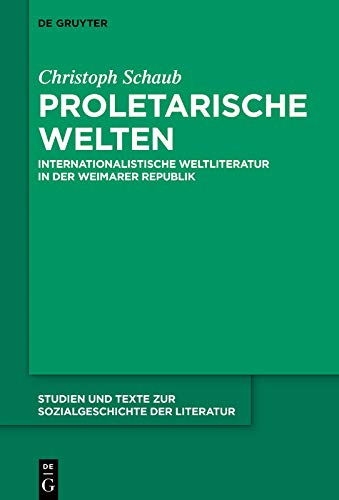
Proletarische Welten: Internationalistische Weltliteratur in der Weimarer Republik by Christoph Schaub
 Discussions of world literature often have little that is concrete to say about class. Recent scholarly interventions have attempted to address this lacuna by grounding theories of world literature in the dynamics of the capitalist world system and the uneven distribution of conditions of labor across the globe. One thinks here of the Warwick Collective’s volume Combined and Uneven Development or Sonali Perera’s No Country. At the same time, volumes like John Lennon and Magnus Nilsson’s Working-Class Literature(s) have sought to re-situate national working-class writing traditions in their original transnational context. Indeed, Michael Denning has written of a proletarian-revolutionary “novelists international” as a kind of second world culture, paralleling the culture of capitalist globalization in its high and low forms in the twentieth century. Christoph Schaub’s Proletarische Welten represents the most forceful attempt so far to lay out the social, institutional, and methodological aspects of proletarian-revolutionary world literary ambitions.
Discussions of world literature often have little that is concrete to say about class. Recent scholarly interventions have attempted to address this lacuna by grounding theories of world literature in the dynamics of the capitalist world system and the uneven distribution of conditions of labor across the globe. One thinks here of the Warwick Collective’s volume Combined and Uneven Development or Sonali Perera’s No Country. At the same time, volumes like John Lennon and Magnus Nilsson’s Working-Class Literature(s) have sought to re-situate national working-class writing traditions in their original transnational context. Indeed, Michael Denning has written of a proletarian-revolutionary “novelists international” as a kind of second world culture, paralleling the culture of capitalist globalization in its high and low forms in the twentieth century. Christoph Schaub’s Proletarische Welten represents the most forceful attempt so far to lay out the social, institutional, and methodological aspects of proletarian-revolutionary world literary ambitions.
The key claim of Schaub’s study is that the proletarian-revolutionary literature of the Weimar Republic in Germany can be read as part of the first broad-based attempt to link a practice of world literature to a mass political movement. This was a world literature of the workers’ movement, or what Schaub labels “internationalist world literature” (1). In contrast to contemporary discourses on world literature in academic circles, this was a practice of world literature that was based less on nation, culture, and identity, than it was on the experiences and imaginaries of global class stratification, and that envisioned world literature less as a terrain of competition and exchange than of antagonistic struggle. At the same time, this internationalist world literature was characterized by a set of social practices distinct from the institutions of circulation that characterize world literature as it is often conceived. Instead of the literary market, the university, and libraries, this internationalist world literature moved across what Schaub dubs “the literary counterpublic spheres” of the international workers’ movement, centered, to be sure, on Moscow, but no less anchored in local working class and Communist milieux and subcultures, with their book clubs, small magazines, and pamphlets, their strikes, demonstrations, and protests. Schaub draws two consequences from this conception of an internationalist world literature operating across literary counterpublic spheres. The first is that center-periphery power relations within the world Communist movement were in fact much more complex than they are often portrayed as being, and the second, not unrelated, consequence is that the proletariat subject of this literature was itself far less homogeneous, or “normative,” than is often thought. The heterogeneous “proletarian worlds” that are imagined and circulated through international world literature in the interwar period are thus examples of a “proletarian modernism of the workers’ movement” (2). This proletarian modernism was characterized for Schaub largely by the techniques of montage and reportage. The study is thus organized into three large chapters, which, respectively, treat counterpublic spheres in interwar international world literature with examinations of authorial practices, publishing ventures, and journals; the role of montage in producing the sense of a common, though spatially and temporally diverse, proletarian horizon (above all in the work of Franz Jung and Anna Seghers); and, finally, Egon Erwin Kisch’s reinvention of montage as a form of discursive solidarity and knowledge production concerning a heterogeneous working class split between capitalist and socialist proletarian worlds.
Schaub’s study marks a fundamental reframing of discussions around world literature, which he performs by reference to the work of B. Venkat Mani and Aamir Mufti on the bourgeois and colonialist underpinnings of certain notions of this project as a kind of global museum of cultures and texts, before turning to a critical reading of the now canonical works of Pascale Casanova and Franco Moretti. Both authors theorize world literature as a circulation of texts more or less within the literary field, to borrow a phrase from Bourdieu; as literary texts that circulate within transnational literary markets and public spheres as world literature. While Casanova’s model describes a world republic of letters shaped by competition and exchange within a literary field dictated by the globalization of a European modernist autonomy aesthetic, Moretti’s model is more open to the formal struggles that characterize world literature, which he, citing Wallerstein’s world-systems theory, sees as a struggle of literary form between center, periphery, and semi-periphery, producing hybrid formations. What neither of these theories can think, according to Schaub, is a world literature that is heteronomous, not in terms of representing a plurality of national traditions, languages, and cultures on however even or slanted a playing field, but in the sense of conflicts between opposing world literary projects. Furthermore, neither Casanova nor Moretti can integrate questions of class antagonism and social stratifications within and across national literatures and world literatures. This is precisely what Schaub is forced to do in analyzing the proletarian-revolutionary literature of the Weimar Republic, which explicitly understood itself as part of the international project of a revolutionary working-class world literature. Not only did this literary endeavor produce its own transnational canon, publishing infrastructure, and network of associations—largely centered on Moscow but loosely coordinated across the globe—but it practiced literature differently, subordinating the literary field to its larger political project, for which texts contribute to the production of knowledge, solidarity, and the construction of imagined and felt “proletarian worlds.”
Schaub’s focus on the counterpublic spheres in which internationalist world literature was produced and circulated also has implications for his notion of the proletariat that this literature represented, appealed to, and perfomatively embodied. Here, Schaub draws on Nancy Fraser and Michael Warner, but the theory of proletarian literary counterpublic spheres in Schaub’s study has Oskar Negt and Alexander Kluge’s definition of the proletarian public sphere as practice of cultural revolution, which is to say the “organization of collective proletarian experience” (50) as its horizon. Like Negt and Kluge’s Public Sphere and Experience, Proletarische Welten is careful to avoid conflation of these categories with either the institutions of the class—parties, unions, and so forth—or with a substantialist, empirically based notion of the proletariat itself. In his readings of texts by Jung, Kisch, and Seghers, Schaub attends to the heterogeneous character of the proletarian worlds that they adumbrate. These texts are focused less on the working class as male, urban, industrial workers than they are with what Schaub describes as “proletarian multiverses,” borrowing the concept from Ernst Bloch, having the effect of “provincializing” at once the capitalist center and the Moscow-centric world Communist movement. These texts often locate themselves in the (semi-) peripheries of the capitalist world system, towards rural labor and the feminized work of social reproduction. Class functions here less as a unified identity than as a “transnationally divided structure of experience” at the core of internationalist world literature. This notion of class has the benefit of not being opposed to categories of race and gender, but of actually being constituted through the very modes in which labors are gendered and bodies racialized in the capitalist world system.
This question also has a bearing on the notion of proletarian realism or modernist realism that Schaub develops through his readings of the use of montage and reportage techniques by Jung, Kisch, and Seghers. It is not unusual to discuss these authors in terms of these techniques, and in turn to use the mutual practice of montage and reportage to bridge the gaps between “high” modernism, the historical avant-gardes, and proletarian-revolutionary writing. Schaub’s study, however, deepens these resonances by moving beyond seeking to validate the serviceability of the term proletarian modernism. Schaub clearly shows how Jung, Seghers, and Kisch refunction (to borrow a coinage from Bertolt Brecht) the techniques of montage and reportage in the service of internationalist world literature and its counterpublic spheres. What is at stake in the use of montage here is precisely neither what is described by Adorno as the capitulation of the artwork to the commodity world it would resist nor the practice of destroying contexts of meaning that Peter Bürger ascribes to the historical avant-garde. Schaub focuses in on Jung’s Joe Frank illustriert die Welt [Joe Frank Illustrates the World] and Seghers’ early novel Die Gefährten [The Wayfarers], demonstrating how montage works in these texts to forge connections across space and time, relying on a tension between the similarities and differences of workers in a world conceived as “a center of mutually interrelated labor struggles and revolutionary movements” that are, as Schaub puts it, following Bloch, nonsynchronous, but also coeval. Relatedly, Schaub’s discussion of Kisch’s reportage practice demonstrates “the racing reporter’s” (as Kisch styled himself) appropriation of a genre that developed largely out of mid-nineteenth century attempts to understand, surveil, and control the nascent urban proletariat. Kisch transforms the reportage into a process of democratic knowledge co-production about an irreducibly heterogeneous proletariat and a “systematically differentiated proletarian modernity” (217) distributed along the axes of capitalist and socialist regimes of labor. This is not the traversable space of globalization, but a globe characterized by “discontinuity, non-integration, and lack of closure” (231). The attentiveness to the simultaneous non-simultaneity of proletarian worlds grounds a practice of “modernist realist” in the work of Jung, Seghers, and Kisch that is, Schaub insists, self-reflexive, referential, and socially constructivist.
While basing an argument about international working-class literature off of more or less German language sources (there is a discussion of Mike Gold’s New Masses, though) may seem counter-intuitive at first, it in fact points back to Schaub’s central point that national cultures themselves are fissured, hybrid, internally-stratified formations sutured in uneven-overlapping ways into transnational markets and public spheres, one of which is “world literature.” While what Schaub describes as international world literature was amputated by the mid-1930s by the rise of fascism and the turn of Comintern culture toward socialist realism and the Popular Front’s foregrounding of national histories and traditions (although I would argue that Popular Front culture was also internationalist, if in a less direct fashion) and has not received commensurate scholarly treatment, it remains more than just a historical curiosity. Rather it represents an attempt to institutionalize, on a world scale, an alternative notion the social function of literature itself in capitalist (and socialist) society, not as a literary field, in Bourdieu’s sense, but as a vehicle for a coeval network of heterogeneous, subaltern counterpublic spheres engaged in the labors of capitalism and the project of world revolution.
Hunter Bivens is Associate Professor of Literature and German Studies at the University of California, Santa Cruz. He is the author of Epic and Exile: Novels of The German Popular Front (2015). His other publications treat the literature and film of the former German Democratic Republic, German proletarian literature, Anna Seghers, and Bertolt Brecht.
Proletarische Welten: Internationalistische Weltliteratur in der Weimarer Republik
By Christoph Schaub
Publisher: Walter de Gruyter
Hardcover / 256 pages / 2019
ISBN: 97813110663594
References:
John Lennon and Magnus Nilsson, ed., Working-Class Literature(s), Historical and International Perspectives(Stockholm: Stockholm University Press, 2017)
Sonali Perera, No Country: Working-Class Writing in the Age of Globalization (New York: Columbia University Press, 2014)
Published on August 4, 2020




